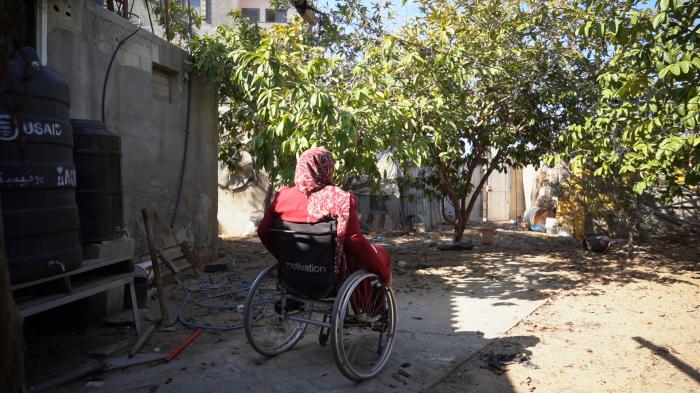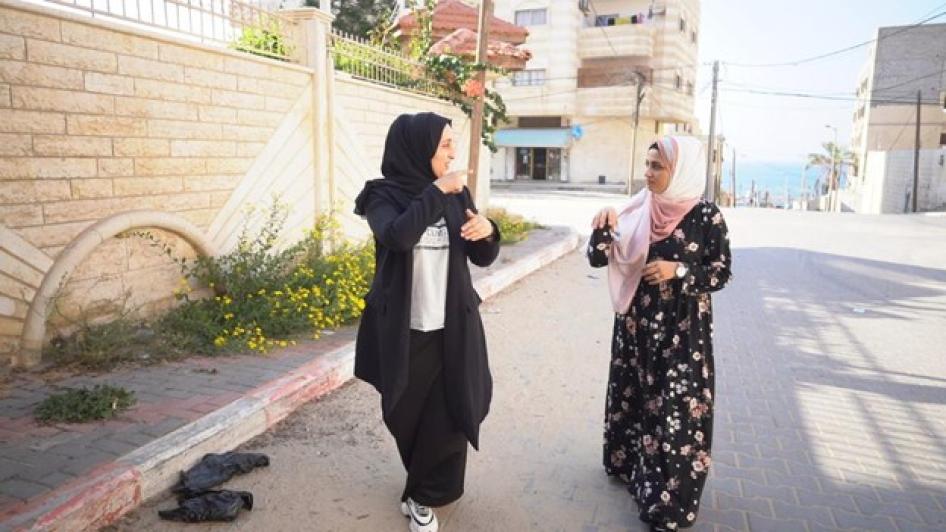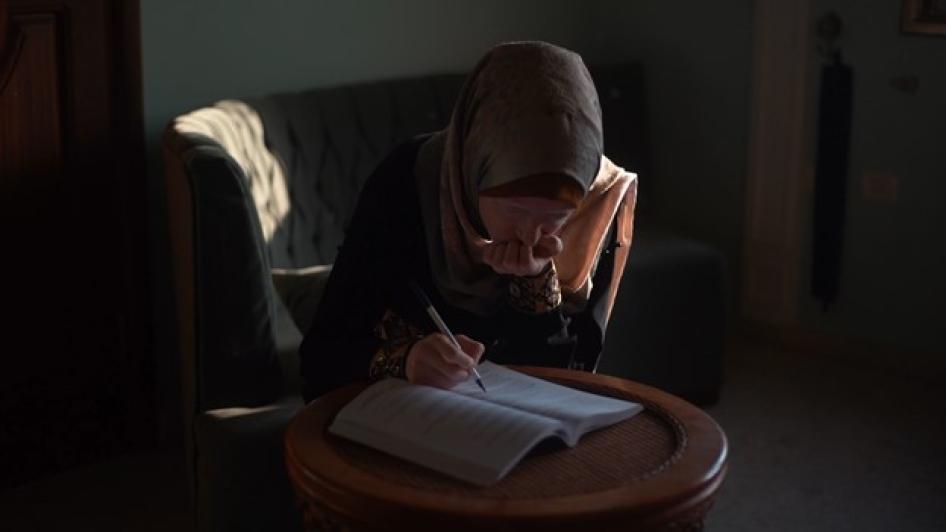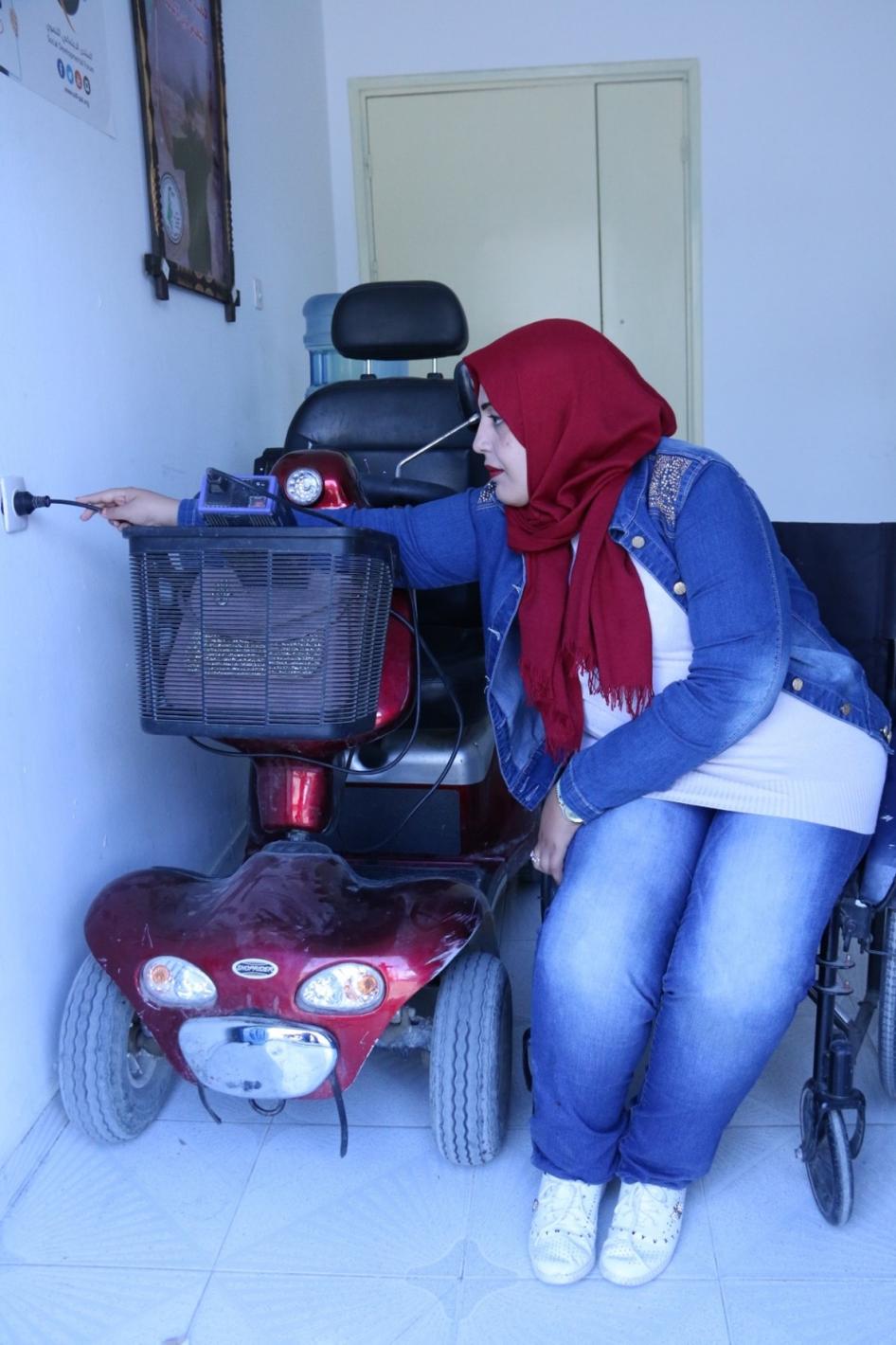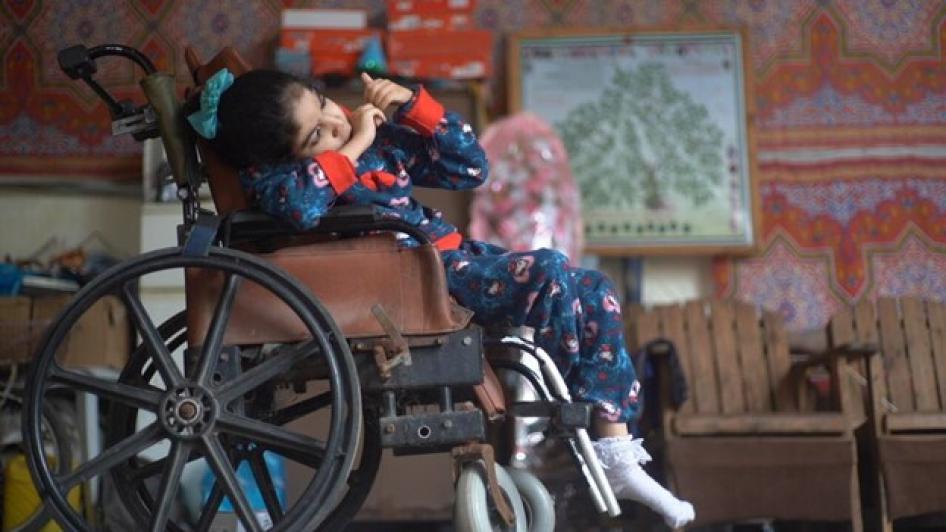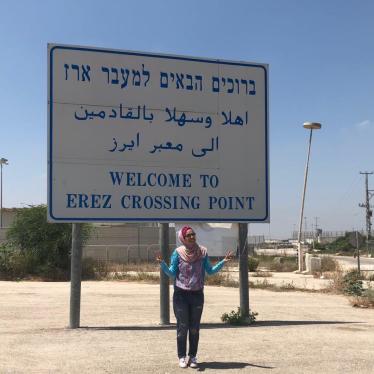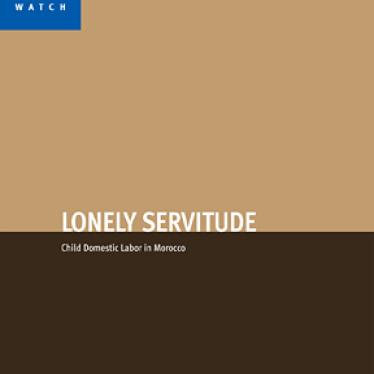(Gaza) – Israel’s 13-year closure of the Gaza Strip along with neglect by Hamas authorities, significantly encumber the day-to-day life of tens of thousands of Palestinians with disabilities, Human Rights Watch said today on the International Day of Persons with Disabilities. Episodes of armed conflict have compounded the barriers that people with disabilities face, which include lack of accessibility of public spaces and widespread stigma.
Sweeping Israeli restrictions on the movement of people and goods, at times exacerbated by restrictive policies by Palestinian authorities, curb access to assistive devices, health care, and electricity essential to many people with disabilities. Chronic power outages in particular jeopardize the rights of many people with disabilities who need light to communicate using sign language, or need equipment powered by electricity to move, including elevators and electric mobility scooters.
“More than a decade of Israeli restrictions have robbed people with disabilities in Gaza of their freedom of movement, and often access to the devices, electricity, and technology they need to communicate or leave their homes,” said Emina Ćerimović, senior researcher in the disability rights division at Human Rights Watch. “These policies, alongside the failure of Hamas authorities to address the lack of accessibility across Gaza and widespread stigma, contribute to making life in Gaza extraordinarily difficult for many people with disabilities.”
Between August 2018 and October 2020, Human Rights Watch interviewed 37 Gaza residents with physical, visual, and hearing disabilities, and family members of six children and one 18-year-old with disabilities. Human Rights Watch also interviewed representatives of 31 international and local organizations operating in Gaza, a representative of a company that imports assistive devices, and local government officials.
Since 2007, Israeli authorities have imposed a generalized travel ban that deprives the two million Palestinians in Gaza of their freedom to leave the 365-square-kilometer strip, outside of narrow exceptions. Israeli authorities have also sharply restricted the entry and exit of goods from Gaza. Israel’s closure of Gaza, exacerbated by Egyptian restrictions on its border with Gaza, limits access to health care, clean water, and electricity, as well as educational, economic, and other opportunities.
Israeli policies, including attacks on Gaza’s sole power plant, restrictions on the entry of parts to repair the plant, and limits on the amount of electricity it sells for Gaza; as well as squabbles between Palestinian authorities over payment for the plant’s fuel, leave Gaza residents on most days with between five and 15 hours of electricity.
These restrictions affect the entire population but have particularly severe consequences for people with disabilities. Doa Qashlan, who uses a mobility scooter, said that the frequent lack of electricity often leaves her trapped at home. “Electricity outages are my biggest fear,” she said. “I need to charge my scooter. Otherwise, I will remain at home, where I feel life stopped.”
According to official statistics from the Palestinian Census Bureau, about 48,000 people in Gaza, or about 2.4 percent of the population, have a disability, more than one-fifth of whom are children. A United Nations Children’s’ Fund (UNICEF) official estimates that the actual figure is much higher. The World Health Organization estimates that about 15 percent of the world’s population has a disability. Some people acquired a disability following injuries stemming from the Israeli authorities’ use of force.
People with disabilities in Gaza also said they faced difficulties accessing assistive devices, such as wheelchairs and hearing aids, due largely to Israeli import restrictions, shortfalls in local authorities’ and aid groups’ provision of necessary devices, and a lack of expertise in Gaza to repair damaged devices. Israel restricts the entry of spare parts and batteries for assistive devices, according to the Israeli rights group Gisha.
Many Gaza residents said that even if their devices, especially wheelchairs, are working, they cannot access many buildings because they lack ramps or elevators. Gaza’s Local Government Ministry in January 2020 for the first time mandated including ramps and elevators in new construction of public buildings, but the regulations do not address the needs of those with visual or other disabilities.
A Gaza City municipal official said that its accessibility strategy prioritizes paving roads but placed little emphasis on infrastructure specifically geared to addressing the needs of people with disabilities.
Discrimination and neglect by Palestinian authorities extend beyond physical accessibility. Three women with hearing disabilities, for example, said that public hospitals do not provide sign language services. “Whenever I go to a hospital without someone to interpret for me, they write on a piece of paper that I should come back and bring someone with me,” one of the women said. “This experience made me feel less of a person.”
People with disabilities also described widespread discrimination and social stigma. Alongside the severe restrictions they face as Gaza residents and as people with disabilities, they confront a particularly “suffocating” reality, as Qashlan put it, with even fewer economic opportunities or outlets than the general population to release the serious “psychological pressure” they face.
A December 2019 report by the UN Office for the Coordination of Humanitarian Affairs (UN OCHA) notes that 498,776 Gaza residents, or nearly 25 percent of Gaza’s population, experience psychosocial distress and have a mental health condition.
By virtue of the significant control that Israel exercises over the lives and welfare of Palestinians in Gaza, Israeli authorities are obliged under the law of occupation and international human rights law, to ensure the welfare of the population there. Palestinians also have the right to freedom of movement, including to and from the West Bank – the other part of the Occupied Palestinian Territory – and the right to leave and return to Gaza. Israel can lawfully restrict those rights only in response to concrete and specific security assessments.
Hamas authorities exercise internal control in Gaza, and therefore also have a direct responsibility to protect people’s rights, including those with disabilities.
The Convention on the Rights of Persons with Disabilities, ratified by Israel in 2012 and Palestine in 2014, obligates Israeli and Palestinian authorities to respect, protect, and fulfill the rights of people with disabilities in Gaza. Those obligations include the right to life, non-discrimination, health, inclusive education, protection and safety in situations of risk, and personal mobility.
Israeli authorities should end the 13-year closure of Gaza. They should also ensure the entry of assistive devices and sufficient electricity to meet the needs of people with disabilities, as well as others, Human Rights Watch said. Hamas authorities should prioritize improving accessibility throughout Gaza, and combat discrimination and stigma, so people with disabilities can participate in their communities on an equal basis with others.
“Both Israeli and Palestinian authorities have systematically overlooked people with disabilities in Gaza,” Ćerimović said. “The Israeli-imposed electricity crisis, shortages of assistive devices, and an inaccessible physical environment, block people with disabilities from living independently and fully participating in their communities.”
Israeli Closure of Gaza
For 25 years, Israel has sharply restricted the movement of Gaza residents. Since 2007, Israel has imposed a generalized travel ban on movement in and out of the territory with narrow exceptions, such as for people needing vital medical treatment outside Gaza and their companions, as well as some prominent businesspeople. Israel restricts movement even for those seeking to travel under these narrow exceptions, including for medical treatment.
Israel’s policy to presumptively deny free movement to the West Bank and beyond, based on generalized security threats and irrespective of any individualized assessment of a person’s security risk, fails the international law requirement reasonably to balance security concerns against the human right to freedom of movement.
Since 2013, Egypt has at times shut its border crossing with Gaza, the area’s only other outlet to the outside world, contributing to the closure. Egyptian authorities beginning in May 2018 opened the crossing more regularly, but have largely shut it since March 2020 amid the Covid-19 pandemic.
Israeli authorities also sharply restrict the entry into and exit of goods from Gaza, in particular “dual-use” materials or items that could be used for military purposes, which has contributed to devastating Gaza’s economy.
Eighty percent of Gaza’s population relies on humanitarian aid, according to the United Nations Relief and Works Agency (UNRWA), which provides direct services to Palestinian refugees. More than half the population lives below the poverty line of US $4.60 per day, and unemployment rates hover around 50 percent.
As a result of the sweeping restrictions on movement, people with disabilities in Gaza, as well as others, face difficulties accessing health care, including services needed specifically because of their disabilities, such as early intervention and services designed to minimize and prevent further disabilities.
Armed Conflict in Gaza and People with Disabilities
A United Nations Commission of Inquiry found that nearly 10 percent of the more than 11,000 Palestinians wounded during 2014 hostilities between Israel and Palestinian armed groups, acquired a physical disability as a result. Physicians for Human Rights Israel said that they include about 100 people who have had a limb amputated. In 2018 and 2019, according to UN OCHA, 156 Palestinians had limbs amputated after being wounded by Israeli fire during demonstrations along the fences separating Gaza and Israel. According to UNICEF, 14 of them were children.
According to the UK-based Medical Aid for Palestinians, 15 people lost their vision and 24 people “were paralysed due to spinal cord injuries” after being shot by Israeli forces during the demonstrations. In addition, the group estimated that at least 1,200 people required “expensive limb reconstruction treatment.”
A March 2019 UN Commission of Inquiry report found that Israeli forces fired on people with disabilities, among other identifiable groups, “knowing who they are,” although protesters did not pose an imminent threat in the vast majority of cases they investigated, making those killings unlawful. The Gaza-based Nusierat Rehabilitation and Social Training Association told Human Rights Watch that the fence protest casualties have “exhausted the consumption of assistive devices.”
Electricity Shortages
Israeli policies sharply limit Gaza’s access to electricity. Gaza’s sole electric power plant has operated at only partial capacity since 2006, in part as a result of Israeli aerial attacks. Israel’s restrictions on the entry of goods, including spare parts and equipment deemed “dual-use,” have hampered efforts to repair the plant
Israeli authorities have also restricted, sometimes punitively and other times as a result of disputes over payments, the amount of industrial fuel it allows to be purchased for the plant. Fuel restrictions further reduce the already-limited supply of electricity, at times for weeks, by more than 50 percent, according to Gisha, the Israeli rights group. Israeli restrictions on the entry of solar panels and batteries also hamper the development of alternate energy sources.
These restrictions force Palestinians in Gaza to rely primarily on buying electricity from Israel. The state-owned Israel Electric Corporation, though, sells only a limited quantity of electricity to Gaza, 120 Megawatts (MW) annually in recent years, outside of a six-month period in 2017 when it cut supply to 70 MW following a request from the Palestinian Authority, linked to the factional rivalry between Fatah and Hamas. The 120 MW is insufficient to meet the demand, which the World Bank said in November 2017 was 450 MW.
According to UN OCHA, the monthly average of electricity available per household per day since 2017 has fluctuated between five and 15 hours, depending on a range of factors, including demand and availability of fuel for Gaza’s power plant. Those who can afford it use alternate energy sources, including generators and solar energy, to supply electricity during power outages.
The extremely limited availability of electricity over long periods affects nearly all aspects of everyday life for Gaza residents, but particularly jeopardizes the rights of people with disabilities. Fadwa Salha, the mother of an 11-year-old girl with cerebral palsy and an intellectual disability, said that her daughter uses a nebulizer when she has trouble breathing, which she cannot operate without electricity, putting her child’s health at risk.
When the power cuts out while her daughter is using the ventilator, Salha said, her daughter’s “chest starts going up and down, she breathes quickly, her heart beats quickly and her eyes move really fast and she has phlegm. Sometimes I cry when electricity is cut off, wishing I could do anything not to see her in that condition.”
Many people with disabilities also need a regular electricity supply to move or communicate. For those with physical disabilities living in a heavily urban context, the electricity schedule dictates when elevators work, and therefore, when they can leave their apartments.
A 25-year-old woman with a physical disability who lives on the eighth floor of a high-rise building, said that she is able to leave her home only when electricity is available to use the elevator. Electricity sometimes comes only at odd hours, she said, and is often unavailable when she needs to go out, including for appointments or to run errands, sometimes for days or weeks at a time. She said she missed a friend’s wedding in March because of a power outage that evening. “I don’t know how to describe my feeling,” she said. “I felt so sad.”
A 26-year-old woman with a physical disability described having to cancel outings due to her inability to charge her mobility scooter. “Electricity shortages control my life,” she said. “It makes me feel more aware of my disability.”
Ahmed Abu Salama, 27, who acquired a disability after being wounded during a 2008 Israeli airstrike, also said electricity outages make it difficult to charge his mobility scooter. Mobility scooters require daily charging, which can take up to 14 hours, more than Gaza residents get most days.
He said the electricity sometimes comes on in the middle of the night, but since residents often avoid leaving devices plugged in overnight for fear that the change in voltage would damage them, he would miss that narrow window to charge it. “Because of this, my scooter sometimes suddenly runs out of charge while I am out, forcing me to call my father to take me home,” he said.
Light in the evenings is crucial for people with disabilities who use visual communication, such as sign language. Human Rights Watch interviewed five women with hearing disabilities who said that they cannot use sign language with family and friends during electrical blackouts.
Lack of Assistive Devices
People in Gaza with disabilities face difficulties getting assistive devices, such as wheelchairs and hearing aids, in part as a result of the Israeli closure. Israeli authorities do not restrict the import of assistive devices, but policies regarding “dual-use” items have restricted the entry of spare parts and batteries for hearing aids and other devices, Gisha said. Medical Aid for Palestinians has documented that Israel has restricted as “dual-use” items, carbon fiber components used to stabilize and treat limb injuries, and carbon fiber and epoxy resins used to produce artificial limbs, resulting in patients being fitted with heavier, more uncomfortable alternatives.
Alaa al-Ayadi, 43, said that his leg was amputated in 2018 after Israeli forces shot him as he protested along the fences with Israel. He said he received a prosthetic leg that did not fit him well and causes him significant pain. According to UNICEF, children whose limbs have been amputated have difficulty getting prosthetic and assistive devices as they grow and require replacements.
Hamas authorities in Gaza and humanitarian organizations have sought to provide assistive devices, but their efforts often fall short. Gaza’s Social Development Ministry reported on its website in September 2017, that it had allocated US $500,000 in its 2018-2020 plan for assistive devices, but it is unclear what devices it secured and distributed, and what standards it relies on to assess need.
Several people with disabilities interviewed in Gaza highlighted difficulties in obtaining free or subsidized assistive devices from local authorities, including long waits. Others said the devices they received were low quality or ill-fitting.
No single system exists in Gaza to compile information about community needs or to coordinate efforts among non-government organizations and local authorities, making some necessary items, such as mobility scooters, unavailable for long periods, while other items were available in excess.
Several people described a lack of expertise in Gaza to repair damaged devices, in part due to Israeli movement restrictions.
The restrictions prevent people from getting training and prevent outside experts from entering Gaza, said the Italian aid organization EducAid, which has an office in Gaza.
Dr. Hassan Ramadan, from the Gaza-based Atfalona Society for Deaf Children, said that Israeli authorities did not respond to requests for permits for him and another staff member to attend a workshop in Jordan in 2019 for treating children who undergo Cochlear Implant Surgery, a procedure to implant electronic devices to stimulate hearing. The Israeli authorities denied permits to four staff members to attend a similar workshop in the West Bank in 2018.
He felt the group had lost the opportunity for hands-on training on the latest methods of evaluation, maintenance of devices, and rehabilitation; and that this diminished the services they can provide to children with hearing disabilities.
Two women with hearing disabilities said that their hearing aids started buzzing in 2017, about two years after they acquired them. They said that the noise gives them severe headaches, but they cannot afford to have them repaired or replaced. “Despite the hearing aids causing me a severe headache, I have to keep it in my ear, so I can hear, for example, the sound of a car horn and avoid any accident,” one of them said.
Other people expressed concern about the possibility of damage to their assistive devices and the inability to have it repaired. “My scooter is as precious as a family member or part of my body,” said Zahra al-Mahoun. “I feel imprisoned without it.”
Inaccessible Environment
Many public institutions and other buildings across Gaza are inaccessible to people with disabilities. Palestinian law applicable in Gaza forbids discrimination based on disability, and guarantees people with disabilities the rights to health care, work, inclusive education, and access to public institutions, but Hamas authorities in Gaza have failed to adequately ensure accessibility. This failure leaves many people with disabilities unable to live independently, or participate in society on an equal basis with others, and at a possible serious risk of injury.
Many parts of Gaza, in particular the overcrowded refugee camps, have poor infrastructure, including narrow, bumpy, and uneven roads. Several people with physical disabilities said they felt the poor condition of roads put them at risk, and that they avoid leaving their homes in rainy weather for fear of accidents on muddy streets.
Doa Qashlan and her sister Abeer, 24, both said they fell off their mobility scooters several times, with Doa once injuring her face and Abeer bruising her body, as a result of the poor condition of the streets where they live in the Nuseirat refugee camp. Mohammad Qanona, 37, said he fell several times, once injuring his head while using his mobility scooter near his home in Deir al-Balah in central Gaza.
In 2012, Gaza’s Local Government ministry set regulations requiring public buildings to guarantee accessibility, but the regulations did not specifically mandate providing ramps or elevators, or address other accessibility requirements. They also lacked clear standards for enforcement and did not address the needs of people with visual or other disabilities. Building regulations is issued by the ministry in January 2020 include more robust physical accessibility requirements, including mandating ramps and elevators for new public buildings, but do not address the accessibility needs of those with visual and other disabilities. A ministry official said that the regulations apply to government facilities, gas stations, and other public institutions, but not private businesses, malls, and mosques.
The Gaza City municipality also has no separate plans for people with disabilities, and instead has prioritized initiatives such as paving roads that serve the entire population, a municipal official said.
Abdelkareem al-Qernawi, 30, said that the Social Development Ministry office in al-Nuseirat refugee camp where he often needs to go has no elevator. He either needs to bring someone with him to help, or waits downstairs until a staff person can come down to see him, which usually takes about an hour. A 30-year-old woman had similar experiences at two Labor Ministry offices in central Gaza Strip.
Gaza residents said that several organizations providing services to people with disabilities in Gaza had themselves not made accommodations for people with disabilities. Siham Abu Oweida, 37, said she attended a training session by a Gaza-based organization that provides services to people with disabilities on the third floor of a private university that had no elevator. She had to crawl up six flights of stairs to participate.
Human Rights Watch observed several organizations that work with people with disabilities that did not provide signs in Braille for those with visual disabilities.
Discrimination and Social Stigma
People with disabilities also face discrimination and social stigma, and are perceived as being helpless, unable to care for themselves, or to make their own decisions. Women with disabilities face discrimination both as women and as people with disabilities. A 26-year-old woman who has a physical disability said: “I hope people see me the same way they see other people. They consider us patients who need treatment, look at us with pity, they don’t think of us as humans.”
She said her family often tells her that no one will want to marry her on account of her physical disability. She described how they often act like she does not exist, not mentioning her even when others ask about the number of people in their family. “I don’t show that I am affected by this, I smile in front of them and hide inside my room to cry,” she added.
Three other women with disabilities also spoke of a widespread perception in Gaza that women with disabilities are unsuitable for marriage, while a man with a physical disability said the family of the woman he hoped to marry told him that they refused to consider him on account of his disability.
The mother of a girl with a physical disability said that her former husband regarded the child as “something that should not have happened,” would not allow her to leave the house so she would not be seen in public, and ultimately left her and the family because he could not accept that his child had a disability.
A 33-year-old woman with a hearing disability said, “When we are in the street using sign language, people look at us and make faces. My friends ask me to stop using sign language. It’s my language, I am proud of it [and] the society should accept it.”
The mother of an 18-year-old woman said when her daughter started displaying signs of a mental health condition as a child, the family despaired and felt they had no access to quality mental health care and psychosocial support for her. She said they decided, when she was 5 years old, to chain her hands and one of her feet during the day to prevent her from smashing things or fleeing the house, only unchaining her at night when she slept with her mother inside a locked room.
The woman’s elder sister said that they feel their only option, given scarce mental health services, is to chain the young woman. Human Rights Watch has documented shackling in 60 countries and found that proper mental health care and support can change such cruel practices.
The authorities have made little effort to combat stigma, such as through initiatives to raise awareness about the rights of people with disabilities, including mental health conditions. One woman with a hearing disability said: “People don’t understand the meaning of disability, they think that we have no ability to do anything. I have a disability and I am proud of my disability.”
Mental Health and Armed Conflict in Gaza
UN OCHA wrote in October of what it called a “mental health crisis in Gaza.” Many people with disabilities described feeling psychological distress as a result of Israel’s closure, as well as the other barriers they face. In particular, many pointed to traumatic experiences during armed hostilities and their difficulty or inability to flee danger in the event of a future attack.
Five people with disabilities described their severe difficulties fleeing civilian buildings that came under attack during Israeli offensives between 2009-2014, and their need for help to reach safety. Israeli forces sometimes provided warnings only minutes before striking–not enough time for people with disabilities to flee. The Geneva Academy in a 2019 report documented a 2014 airstrike that killed two people with disabilities, who could not evacuate a civilian building in the two minutes between receiving a “roof-knock warning” and the strike itself.
The 26-year-old woman with a physical disability said that, when a missile struck her house during the 2014 war, she tried to flee with the rest of her family but was wounded by shrapnel in her leg and remained stuck in the house for another 15 minutes, until a relative helped her out. She said the attack damaged her mobility scooter, which she said felt like “losing a member of a family.” Six years later, she said, she still hears the “sound of explosions in my head,” gets frightened whenever she hears ambulances, and avoids “looking at the sky.”
Ahmed Abu Salama, 27, said that, during the 2014 hostilities, an Israeli drone struck a mosque while he was praying there. Everyone fled but he froze, unsure if he could flee in his wheelchair. He waited a few minutes until some people returned and carried him out. In the 2008-2009 hostilities, he said, a bullet struck the wall above his head in the hospital room where he laid, and he managed to escape only with another person’s help. Abu Salama said that the incidents stayed with him and to this day he is startled every time he hears a loud sound.
